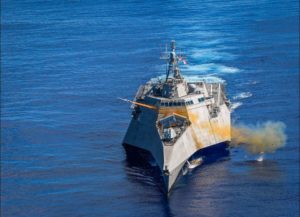The Navy tested the new Naval Strike Missile (NSM) from the Independence-variant Littoral Combat Ship USS Gabrielle Giffords (LCS-10) in a Pacific test on Tuesday.
During the biennial Pacific Griffin exercise in waters near Guam, LCS-10 and other vessels participated in a sinking exercise (SINKEX) of the decommissioned ex-USS Ford (FFG-54). The exercise included both U.S. and Singapore participants.

Units that participated in the SINKEX include the Giffords with the NSM, missile-launching maritime patrol craft from Patrol Squadrons VP-1, VP-5 and VP-47; B-52 bombers from the Air Forces’ Expeditionary 69th Bomb Squadron; and Singapore multi-role frigates RSS Formidable (FFS-68) and RSS Intrepid (FFS-69) launching surface-to-surface Harpoon missiles.
Pacific Griffin seeks to “enhance combined proficiency at sea while strengthening relationships between the U.S. and Republic of Singapore navies,” the U.S. Navy said.
A Navy official said the deployment of the Giffords with the NSM sends a message about U.S. commitment to regional security.
“LCS packs a punch and gives potential adversaries another reason to stay awake at night. We are stronger when we sail together with our friends and partners, and LCS is an important addition to the lineup,” Rear Adm. Joey Tynch, commander, Logistics Group Western Pacific, said in a statement.
While the NSM was first demonstrated on an LCS in 2014 with the USS Coronado (LCS-4), this is the first time an NSM-equipped ship has sailed into the Indo-Pacific region.
LCS-10 arrived in the 7th Fleet area of responsibility on Sept. 16 for a rotational deployment to the region, the first time two LCSs have deployed to the region simultaneously. The Navy underscored the NSM aboard the ship is “fully operational and remains lethal.”
The Naval Strike Missile is a long-range precision strike weapon that can hit enemy ships at a range of up to 100 nautical miles while flying at sea-skimming altittudes to avoid detection. NSM was originally developed by Norway’s Kongsberg and is working with Raytheon [RTN] to integrate the Over the Horizon (OTH) capability into LCSs.
Kongsberg and Raytheon first announced cooperation for the NSM in a 2015 teaming agreement (Defense Daily, April 8, 2015).
Last year, Raytheon won a $15 million contract for the OTH missile program to be used by LCSs and the future guided-missile frigate, FFG(X) (Defense Daily, May 31)